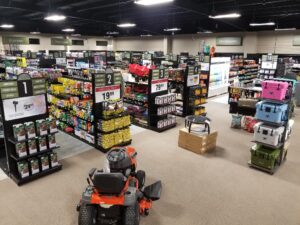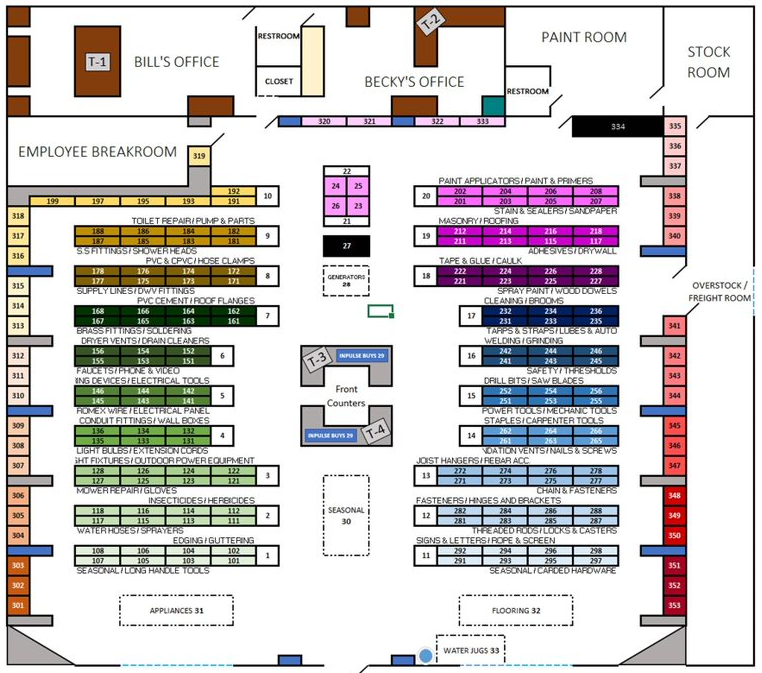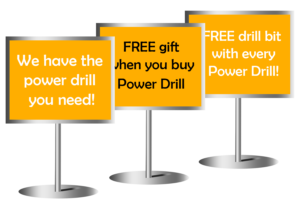Signage: Get the Most from Your Silent Salesman
Is the signage in your store suffering from neglect? Are your customers completely oblivious to your signs and, even worse, their message? How can you make all your signage more effective? In-store signage, also known as “a silent salesman,” is as important as ever.
Customers are making more and more buying decisions in the store as they become numb to the barrage of advertising done by brand-name marketing and traditional advertising. Even if the message is spot on, sign placement could be one of the many reasons customers are turning a blind eye. Today’s dynamic digital in-store signage adds another layer of advertising messages.
These are just a couple of the many insights Paco Underhill shares in his book, “Why We Buy.” Underhill and his team of trackers have stationed themselves in stores, banks, restaurants, and retail establishments of all types, to closely watch customer behavior for over 30 years. His clients include many high profile American companies as well as companies throughout Europe, South America, and Asia.
Underhill has amassed an incredible amount of data about customer behavior. In the book, Underhill demonstrates how he used his observations to help his clients increase sales by using signage more effectively. This article covers a few of the ways you can boost the effectiveness of your “silent salesman.”
1) Move Your Silent Salesman to The Edge
 As a customer approaches a store from the street or parking lot they are generally moving quickly. If they aren’t busy avoiding traffic, they might be trying to get out of the weather.
As a customer approaches a store from the street or parking lot they are generally moving quickly. If they aren’t busy avoiding traffic, they might be trying to get out of the weather.
The faster they move, the narrower their peripheral vision, making them unable to take in visual cues that would be obvious to someone just strolling along.
If you can’t present a big, bold, short, and simple, message to shoppers heading toward the store, you’re not going to reach them.
Once inside the door, it takes a considerable amount of space for a shopper to slow down. Depending on the individual, the distance they cover could be anywhere from 12 to 25 feet. As deceleration takes place, the customer’s brain needs to shift gears to take in the new environment. Eyes adjust to the light. Heads turn left and right to survey the interior of the store. Ears and noses take in more stimuli as sounds and smells are analyzed.
With so much going on at one time, anything facing the customer in the first 10 feet inside the front door will go unnoticed. A merchandise display, a stack of flyers, signage, or shopping baskets might as well not be there. The shopper is oblivious. By the time shoppers slow down enough to notice anything, these items are behind them. This area is known as “The Decompression Zone”.
Placing these items same items 12 to 20 feet inside the door puts these items near the edge of the Decompression Zone and increases the likelihood of customer interaction by roughly 30% percent. If these items are placed to the customer’s right side chance of interaction increases even more. Hours of film and videotape by Underhill and his team show that shoppers reflexively turn to the right to exit the Decompression Zone.
2) Map Out Your Sales Floor

Any available blank space in a store is not necessarily a good place to post one of your silent salesmen. Underhill sees the retail space as a series of zones that need to be identified before posting a single sign. It’s vitally important to determine what the customer will be doing, and where they will be looking when inhabiting a particular zone. The perfect message in one space could be completely wrong for another.
If a customer is moving quickly through an area the message will need to be short and to the point. Placing a sign that requires twelve seconds to read into an area the customer will inhabit for five seconds is unlikely to be effective. For example, a customer entering a fast food restaurant is probably looking for one of two things, the counter or the restroom. Any message placed between the door and either of these two destinations probably won’t register.
On the other hand, if customers are browsing or standing around waiting, there may be an opportunity to deliver a more detailed message.
Lawnmower maker Toro created an in-store video to promote their new line of mowers. Placing the video display in the space where their mowers were sold would make it difficult for shoppers to view. In the ten minutes or so it would take shoppers to watch the entire video, they would likely be interrupted several times by shoppers on their way to other parts of the store.
Instead, they situated the video displays in the repair department waiting areas of home and garden supply stores. Toro realized that shoppers in the service area are desperate for something to do and likely to be open to any message put before them. The repair customers are also likely to be looking for a new mower in the future.
Observe how your customers move on the sales floor and watch what they’re doing in different areas. Identify both high traffic areas as well as regions where the pace is slower. If you want to present any kind of message in areas where customers are moving quickly, it’s going to have to be brief and to-the-point. Any area where customers are browsing or waiting for a service to be performed creates an opportunity to present a more detailed message.
3) Layer Your Message
A single sign doesn’t have to contain your entire message. You can break the message you wish to convey into smaller pieces, even two or three parts, giving the shopper more and more information as they get deeper into the store.
Start by attracting their attention. Once the customer is tuned in you can tell them anything else you want them to know in a logical, orderly sequence. The message should be delivered in a way they can easily take in. Too much information too fast will overload the customer and they’ll give up. Confuse them and they’ll overlook your message completely.
Fast food restaurants have mastered message layering. They start with a message on the street or near the entrance. Two or three words designed to grab your attention and hopefully get you in the door. (½ Off Megameal!) Once in the door, a strategically placed silent salesman can re-convey the Megameal offer and give a few important details.
After the order is placed, there’s time to kill while the food is being prepared. McDonald’s found that 75% of the customers read the menu board after they order while waiting for their food which took about one minute, forty seconds. A long look at the menu board might inspire the customer to try something different next time they’re in or add to their current order.
Food’s ready! Time to get some ketchup for the fries. Lo and behold, a sign at the condiment station displays pictures and information about all the available desserts.
Many fast-food diners eat alone. With food in front of them,  many are starved for something to amuse them while they eat. Underhill’s observations have shown that messages on napkins, table tents, and tray liners that would be ignored in family restaurants will be devoured in the dining area of a fast-food restaurant.
many are starved for something to amuse them while they eat. Underhill’s observations have shown that messages on napkins, table tents, and tray liners that would be ignored in family restaurants will be devoured in the dining area of a fast-food restaurant.
Notice the logic in the sequencing. There was nothing mentioned about hamburgers at the condiment station. It’s too late. They have their hamburger. The same would be true in a checkout line at a grocery or hardware store. Advertising something available at the back of the building isn’t likely to be acted upon by people ready to pay and move on.
The same layering technique can work for any business. Let’s try it out on a hardware store.
The signs on the street could say something short and catchy like, “We’ve Got Your Tool”. If that gets them out of their car, the silent salesman just beyond the edge of the Decompression Zone can inform the customer about the various discounts on power tools. If you’d like to add another layer to add some drama to draw the process out a bit further, this same sign could say, “Free Gift with Every New DeWalt Tool. Check the Tool Isle for Details.”
Once inside the tool isle, you can let them know which free gifts go with which tool. Each sign reveals a little more and draws the customer in a little further until they’re standing right where you want them, smack-dab in the tool isle.
Salesman: Take over, please.
The Takeaway
Short of welcoming the customer, don’t try to convey any important information within the Decompression Zone, just inside the front door. Give shoppers the space they need to slow their pace and adjust to their new surroundings before offering them anything.
By taking careful account of the layout a store and understanding how customers behave in different areas, you can deliver your message more effectively and get more from every silent salesman inside and outside the store. Breaking the message down into easily digestible pieces allows you to deliver a more complete message to customers by adding additional layers of information as they move deeper into your store.
George Maginnis
Author


